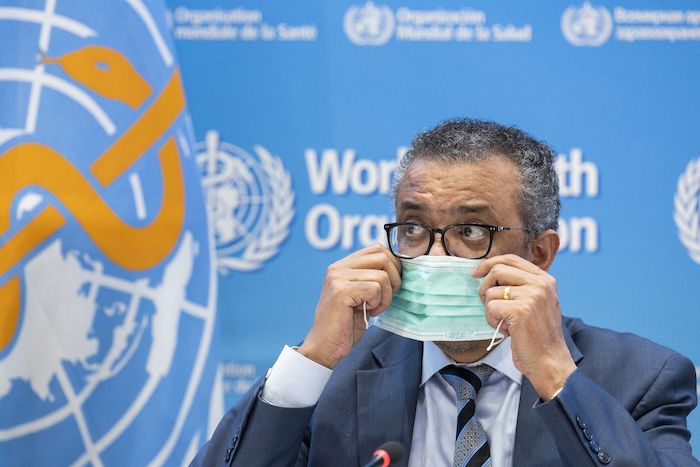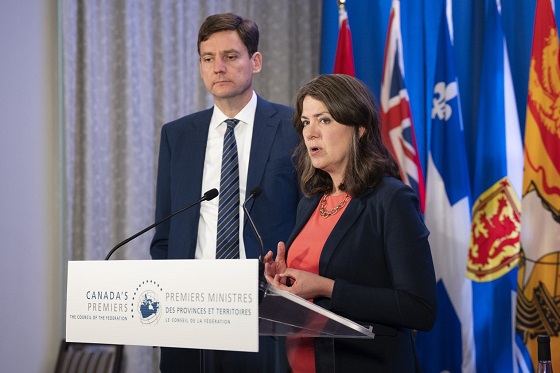Brownstone Institute
WHO Accords Warrant Sovereignty Concern

From the Brownstone Institute
BY
In agreeing to undertake to implement the WHO advisories, states will be creating a new system of pandemic management under the WHO authority and binding under international law. It will create an open-ended international law obligation to cooperate with the WHO and to fund it.
On 11 March, my article criticizing what appeared to be a slow-motion coup d’état by the World Health Organization (WHO) to seize health powers from states in the name of preparing for, conducting early warning surveillance of, and responding to “public health emergencies of international [and regional] concern” was published in the Australian. The coup was in the form of a new pandemic treaty and an extensive package of more than 300 amendments to the existing International Health Regulations (IHR) that was signed in 2005 and came into force in 2007, together referred to as the WHO pandemic accords.
The two sets of changes to the architecture of global health governance, I argued, will effectively change the WHO from a technical advisory organisation offering recommendations into a supranational public health authority telling governments what to do.
On 3 May, the Australian published a reply by Dr. Ashley Bloomfield, co-chair of the WHO working group on the IHR amendments. Bloomfield was New Zealand’s Director-General of Health from 2018–22 and received a knighthood for his services in the 2024 New Year’s Honours list. His engagement with the public debate is very welcome.
Rejecting the charge that the WHO is engaged in a power grab over states, Bloomfield wrote that as a one-time senior UN official, I “would know that no single member state is going to concede sovereignty, let alone the entire 194 members.”
I bow to the good doctor’s superior medical knowledge in comparison to my non-existent medical qualifications.
Unfortunately, I cannot say the same with respect to reforms across the UN system, or sovereignty, or the relationship between “We the peoples” (the first three words of the UN Charter), on the one hand, and UN entities as agents in the service of the peoples, on the other. On medical and not health policy issues, I would quickly find myself out of my depth. I respectfully submit that on sovereignty concerns, Dr. Ashley may be the one out of his depth.
On the first point, I was seconded to the UN Secretariat as the senior adviser to Kofi Annan on UN reforms and wrote his second reform report that covered the entire UN system: Strengthening the United Nations: An Agenda for Further Change (2002). The topic of UN reforms, both the case for it and the institutional and political obstacles frustrating the achievement of the most critical reforms, forms a core chapter of my book The United Nations, Peace and Security (Cambridge University Press, 2006, with a substantially revised second edition published in 2017).
I was also involved in a small Canada-based group that advocated successfully for the elevation of the G20 finance ministers’ group into a leaders’ level group that could serve as an informal grouping for brokering agreements on global challenges, including pandemics, nuclear threats, terrorism, and financial crises. I co-wrote the book The Group of Twenty (G20) (Routledge, 2012) with Andrew F. Cooper, a colleague in that project.
On the second point, I played a central role in the UN’s reconceptualisation of sovereignty as state responsibility and citizens as rights holders. This was unanimously endorsed by world leaders at the UN summit in 2005.
On the third point, in Utopia Lost: The United Nations and World Order (1995), Rosemary Righter (the former chief leader writer at the Times of London) quoted Alexander Solzhenitsyn’s description of the United Nations as “a place where the peoples of the world were delivered up to the designs of governments” (p. 85).
So yes, I do indeed know something about UN system reforms and the importance of sovereignty concerns in relation to powers given to UN bodies to prescribe what states may and may not do.
In agreeing to undertake to implement the WHO advisories, states will be creating a new system of pandemic management under the WHO authority and binding under international law. It will create an open-ended international law obligation to cooperate with the WHO and to fund it. This is the same WHO that has a track record of incompetence, poor decision-making, and politicised conduct. The insistence that sovereignty is not being surrendered is formulaic and legalistic, not substantive and meaningful in practice.
It relies on a familiar technique of gaslighting that permits plausible deniability on both sides. The WHO will say it only issued advisories. States will say they are only implementing WHO recommendations as otherwise, they will become rogue international outlaws. The resulting structure of decision-making effectively confers powers without responsibility on the WHO while shredding accountability of governments to their electorates. The losers are the peoples of the world.
A “Litany of Lies” and Misconceptions? Not So Fast.
Bloomfield’s engagement with the public debate on the WHO-centric architecture of global health governance is very welcome. I have lauded the WHO’s past impressive achievements in earlier writings, for example in the co-written book Global Governance and the UN: An Unfinished Journey (Indiana University Press, 2010). I also agree wholeheartedly that it continues to do a lot of good work, 24/7. In early 2020 I fought with a US editor to reject a reference to the possible virus escape from the Wuhan lab because of WHO’s emphatic statements to the contrary. I later apologised to him for my naivete.
Once betrayed, twice shy of the message: “Trust us. We are from the WHO, here to keep you safe.”
Sir Ashley was merely echoing the WHO chief. Addressing the World Governments Summit in Dubai on 12 February, Director-General (DG) Tedros Adhanom Ghebreyesus attacked “the litany of lies and conspiracy theories” about the agreement that “are utterly, completely, categorically false. The pandemic agreement will not give WHO any power over any state or any individual.”
DG Tedros and Sir Ashley do protest too much. If Australia chooses as a sovereign nation to sign them, that does not mean there is no loss of effective sovereignty (that is, the power to make its health decisions) from that point on.
This is why all 49 Republican senators have “strongly” urged President Joe Biden to reject the proposed changes. The expansion of “WHO’s authority over member states during” pandemic emergencies, they warn, would “constitute intolerable infringements upon US sovereignty.” In addition, 22 Attorneys-General have informed Biden that the WHO writ under the new accords will not run in their states.
On 8 May, the UK said it would not sign the new treaty unless clauses requiring transfer of pandemic products were deleted. Under Article 12.6.b of the then-draft, the WHO could sign “legally binding” contracts with manufacturers to get pandemic-related “diagnostics, therapeutics or vaccines.” Ten percent of this is to be free of charge and another ten percent at profit-free prices. In the latest, 22 April draft, this last requirement comes in Article 12.3.b.i in slightly softer language.
The UK wants to retain the right to use British-made products first to address domestic requirements as judged by the government, and only then to make them available for global distribution. The draft, the government fears, will undermine British sovereignty.
On 14 May, five senators and nine representatives from the Australian parliament wrote a formal letter to PM Anthony Albanese expressing deep concern over the likely prospect of Australia signing the accords that “will transform the WHO from an advisory organisation to a supranational health authority dictating how governments must respond to emergencies which the WHO itself declares.” If adopted and implemented into Australian law, they wrote, these would give the WHO “an unacceptable level of authority, power and influence over Australia’s affairs under the guise of declaring ‘emergencies’.”
“Legally Binding” vs “Loss of Sovereignty” is a Distinction without a Difference
They can’t all be part of a global conspiracy to peddle a litany of lies. The WHO is offering up a highly specious argument. Sir Ashley didn’t really engage with the substance of my arguments either. He dismissed criticism of the proposed changes as “an attempt by the WHO to gain the power to dictate to countries what they must do in the event of a pandemic” as a “misconception.”
The G20 Leaders’ Bali Declaration (November 2022, paragraph 19) supported the goal of a “legally binding instrument that should contain both legally binding and non-legally binding elements to strengthen pandemic planning, preparedness and response (PPR) and amendments to the IHR.” In September 2023, the G20 Delhi Leaders’ Declaration (28:vi) envisioned “an ambitious, legally binding WHO” accord “as well as amendments to better implement” the IHR.
Lawrence Gostin, actively involved in the negotiations, was co-author of a report last December that said containing transnational outbreaks under WHO leadership “may require all states to forgo some level of sovereignty.” A joint Reuters-World Economic Forum article on 26 May 2023 stated: “For the new more wide-reaching pandemic accord, member states have agreed that it should be legally binding.”
The WHO itself describes the IHR as “an instrument of international law that is legally-binding on 196 countries.” Last year it published a document that includes section 4.6 on “legally binding international instruments” such as a new pandemic accord.
I get the argument that sovereign states are voluntarily agreeing to this. In terms of legal technicality, it might well be more accurate, as Libby Klein suggests in her draft letter to Australian MPs, to use words and phrases like “ceding autonomy,” “yielding “effective control over public health decisions,” “outsourcing public health decision-making to the WHO,” or “offshoring our public health decision-making.” This is the legalistic distinction that Bloomfield is effectively making.
However, simply because states must voluntarily sign the new WHO accords doesn’t mean they will not be ceding sovereignty once the accords are adopted. With all due respect to Dr. Tedros and Sir Ashley, this is a distinction without a difference. Every single “legally binding” requirement will mean a transfer of effective decision-making power on health issues to the WHO. That is a curtailment of state sovereignty and it is disingenuous to deny it.
Since the creation of the United Nations in 1945, states have been required to conduct themselves increasingly in conformity with international standards. And it is the UN system that sets most of the relevant international standards and benchmarks of state behaviour.
For example, for centuries countries had the absolute right to wage wars of aggression and defence as an acknowledged and accepted attribute of sovereignty. By adopting the United Nations Charter in 1945, they gave up the right to wage aggressive wars. I am very glad they did so. Just because the surrender of this aspect of sovereignty was voluntary, it doesn’t mean there was no surrender of sovereignty.
Similarly, by signing the Nuclear Non-proliferation Treaty (NPT), Australia and around 185 states surrendered their sovereign right to make or get the nuclear bomb. Again, I am very glad they did so.
Article 10 of the treaty does permit withdrawal after a three-month notice to other states parties and the UN Security Council:
Each Party shall in exercising its national sovereignty have the right to withdraw from the Treatyif it decides that extraordinary events…have jeopardisedthe supreme interests of its country.
Australia could still act as a sovereign state and pull out of the NPT but, absent exculpatory events, only at the reputational cost of acting illegally under international law.
North Korea first announced withdrawal from the NPT in 1993, suspended the withdrawal, withdrew in 2003, has conducted six nuclear tests since 2006, and acquired up to 50 bombs. Yet, the UN has refused to accept the withdrawal and it is still listed on the UN website as an NPT member, with the explanatory note that: “States parties to the Treaty continue to express divergent views regarding the status of the DPRK under the NPT.”
Like these two important examples, states will lose key parts of the right to exercise their sovereignty over national policy settings and decisions on health if the WHO accords are adopted. It is their sovereign right to reject the treaties now. They should exercise it before it is too late. The complications entangling the post-Brexit referendum in the UK demonstrate only too vividly how challenging it can be for a state to extricate itself from a supranational authority despite the sovereign right to do so.
The best way to allay these fears and concerns would be to return responsibility to where accountability lies: with the national government and parliament. States should learn to cooperate better in global pandemic management, not hand effective decision-making powers and authority to unelected and unaccountable international technocrats.
The Effort Should Be Put on Indefinite Hold
It is an iron law of politics that any power that can be abused, will be abused by someone, somewhere, some time in the future. For current examples of overreach by a technocrat, look no further than Australia’s eSafety Commissioner. The truly frightening thing about her example is the realisation of just how much her efforts have been deliberately embedded in a global campaign to “bureaucratise” and control the internet.
A softer conclusion is that powers once granted over citizens to authorities are far more difficult to claw back than not giving them the powers in the first place. Thus far from retreating, the Censorship-Industrial Complex is simultaneously being broadened to embrace additional sectors of governance and public policy and globalised.
A report from Leeds University documented that pandemics are rare events. They are not becoming more frequent. For poor countries, their global disease burden is much lower than that of the big killer diseases like TB, malaria, and HIV/AIDS. For industrialised countries like Australia, the disease burden has been greatly reduced since the Spanish flu with improved surveillance, response mechanism, and other public health interventions.
There is no emergency justifying the rushed process. An immediate pause and a slow and deliberative process would lead to better policy development and deliver better national and global health policy outcomes.
“Pause for thought, argue for a wider delay, think it through properly. And don’t sign till it’s right.” David Frost, who led the UK Brexit negotiations.
Just so.
Brownstone Institute
Bizarre Decisions about Nicotine Pouches Lead to the Wrong Products on Shelves

From the Brownstone Institute
A walk through a dozen convenience stores in Montgomery County, Pennsylvania, says a lot about how US nicotine policy actually works. Only about one in eight nicotine-pouch products for sale is legal. The rest are unauthorized—but they’re not all the same. Some are brightly branded, with uncertain ingredients, not approved by any Western regulator, and clearly aimed at impulse buyers. Others—like Sweden’s NOAT—are the opposite: muted, well-made, adult-oriented, and already approved for sale in Europe.
Yet in the United States, NOAT has been told to stop selling. In September 2025, the Food and Drug Administration (FDA) issued the company a warning letter for offering nicotine pouches without marketing authorization. That might make sense if the products were dangerous, but they appear to be among the safest on the market: mild flavors, low nicotine levels, and recyclable paper packaging. In Europe, regulators consider them acceptable. In America, they’re banned. The decision looks, at best, strange—and possibly arbitrary.
What the Market Shows
My October 2025 audit was straightforward. I visited twelve stores and recorded every distinct pouch product visible for sale at the counter. If the item matched one of the twenty ZYN products that the FDA authorized in January, it was counted as legal. Everything else was counted as illegal.
Two of the stores told me they had recently received FDA letters and had already removed most illegal stock. The other ten stores were still dominated by unauthorized products—more than 93 percent of what was on display. Across all twelve locations, about 12 percent of products were legal ZYN, and about 88 percent were not.
The illegal share wasn’t uniform. Many of the unauthorized products were clearly high-nicotine imports with flashy names like Loop, Velo, and Zimo. These products may be fine, but some are probably high in contaminants, and a few often with very high nicotine levels. Others were subdued, plainly meant for adult users. NOAT was a good example of that second group: simple packaging, oat-based filler, restrained flavoring, and branding that makes no effort to look “cool.” It’s the kind of product any regulator serious about harm reduction would welcome.
Enforcement Works
To the FDA’s credit, enforcement does make a difference. The two stores that received official letters quickly pulled their illegal stock. That mirrors the agency’s broader efforts this year: new import alerts to detain unauthorized tobacco products at the border (see also Import Alert 98-06), and hundreds of warning letters to retailers, importers, and distributors.
But effective enforcement can’t solve a supply problem. The list of legal nicotine-pouch products is still extremely short—only a narrow range of ZYN items. Adults who want more variety, or stores that want to meet that demand, inevitably turn to gray-market suppliers. The more limited the legal catalog, the more the illegal market thrives.
Why the NOAT Decision Appears Bizarre
The FDA’s own actions make the situation hard to explain. In January 2025, it authorized twenty ZYN products after finding that they contained far fewer harmful chemicals than cigarettes and could help adult smokers switch. That was progress. But nine months later, the FDA has approved nothing else—while sending a warning letter to NOAT, arguably the least youth-oriented pouch line in the world.
The outcome is bad for legal sellers and public health. ZYN is legal; a handful of clearly risky, high-nicotine imports continue to circulate; and a mild, adult-market brand that meets European safety and labeling rules is banned. Officially, NOAT’s problem is procedural—it lacks a marketing order. But in practical terms, the FDA is punishing the very design choices it claims to value: simplicity, low appeal to minors, and clean ingredients.
This approach also ignores the differences in actual risk. Studies consistently show that nicotine pouches have far fewer toxins than cigarettes and far less variability than many vapes. The biggest pouch concerns are uneven nicotine levels and occasional traces of tobacco-specific nitrosamines, depending on manufacturing quality. The serious contamination issues—heavy metals and inconsistent dosage—belong mostly to disposable vapes, particularly the flood of unregulated imports from China. Treating all “unauthorized” products as equally bad blurs those distinctions and undermines proportional enforcement.
A Better Balance: Enforce Upstream, Widen the Legal Path
My small Montgomery County survey suggests a simple formula for improvement.
First, keep enforcement targeted and focused on suppliers, not just clerks. Warning letters clearly change behavior at the store level, but the biggest impact will come from auditing distributors and importers, and stopping bad shipments before they reach retail shelves.
Second, make compliance easy. A single-page list of authorized nicotine-pouch products—currently the twenty approved ZYN items—should be posted in every store and attached to distributor invoices. Point-of-sale systems can block barcodes for anything not on the list, and retailers could affirm, once a year, that they stock only approved items.
Third, widen the legal lane. The FDA launched a pilot program in September 2025 to speed review of new pouch applications. That program should spell out exactly what evidence is needed—chemical data, toxicology, nicotine release rates, and behavioral studies—and make timely decisions. If products like NOAT meet those standards, they should be authorized quickly. Legal competition among adult-oriented brands will crowd out the sketchy imports far faster than enforcement alone.
The Bottom Line
Enforcement matters, and the data show it works—where it happens. But the legal market is too narrow to protect consumers or encourage innovation. The current regime leaves a few ZYN products as lonely legal islands in a sea of gray-market pouches that range from sensible to reckless.
The FDA’s treatment of NOAT stands out as a case study in inconsistency: a quiet, adult-focused brand approved in Europe yet effectively banned in the US, while flashier and riskier options continue to slip through. That’s not a public-health victory; it’s a missed opportunity.
If the goal is to help adult smokers move to lower-risk products while keeping youth use low, the path forward is clear: enforce smartly, make compliance easy, and give good products a fair shot. Right now, we’re doing the first part well—but failing at the second and third. It’s time to fix that.
Addictions
The War on Commonsense Nicotine Regulation

From the Brownstone Institute
Cigarettes kill nearly half a million Americans each year. Everyone knows it, including the Food and Drug Administration. Yet while the most lethal nicotine product remains on sale in every gas station, the FDA continues to block or delay far safer alternatives.
Nicotine pouches—small, smokeless packets tucked under the lip—deliver nicotine without burning tobacco. They eliminate the tar, carbon monoxide, and carcinogens that make cigarettes so deadly. The logic of harm reduction couldn’t be clearer: if smokers can get nicotine without smoke, millions of lives could be saved.
Sweden has already proven the point. Through widespread use of snus and nicotine pouches, the country has cut daily smoking to about 5 percent, the lowest rate in Europe. Lung-cancer deaths are less than half the continental average. This “Swedish Experience” shows that when adults are given safer options, they switch voluntarily—no prohibition required.
In the United States, however, the FDA’s tobacco division has turned this logic on its head. Since Congress gave it sweeping authority in 2009, the agency has demanded that every new product undergo a Premarket Tobacco Product Application, or PMTA, proving it is “appropriate for the protection of public health.” That sounds reasonable until you see how the process works.
Manufacturers must spend millions on speculative modeling about how their products might affect every segment of society—smokers, nonsmokers, youth, and future generations—before they can even reach the market. Unsurprisingly, almost all PMTAs have been denied or shelved. Reduced-risk products sit in limbo while Marlboros and Newports remain untouched.
Only this January did the agency relent slightly, authorizing 20 ZYN nicotine-pouch products made by Swedish Match, now owned by Philip Morris. The FDA admitted the obvious: “The data show that these specific products are appropriate for the protection of public health.” The toxic-chemical levels were far lower than in cigarettes, and adult smokers were more likely to switch than teens were to start.
The decision should have been a turning point. Instead, it exposed the double standard. Other pouch makers—especially smaller firms from Sweden and the US, such as NOAT—remain locked out of the legal market even when their products meet the same technical standards.
The FDA’s inaction has created a black market dominated by unregulated imports, many from China. According to my own research, roughly 85 percent of pouches now sold in convenience stores are technically illegal.
The agency claims that this heavy-handed approach protects kids. But youth pouch use in the US remains very low—about 1.5 percent of high-school students according to the latest National Youth Tobacco Survey—while nearly 30 million American adults still smoke. Denying safer products to millions of addicted adults because a tiny fraction of teens might experiment is the opposite of public-health logic.
There’s a better path. The FDA should base its decisions on science, not fear. If a product dramatically reduces exposure to harmful chemicals, meets strict packaging and marketing standards, and enforces Tobacco 21 age verification, it should be allowed on the market. Population-level effects can be monitored afterward through real-world data on switching and youth use. That’s how drug and vaccine regulation already works.
Sweden’s evidence shows the results of a pragmatic approach: a near-smoke-free society achieved through consumer choice, not coercion. The FDA’s own approval of ZYN proves that such products can meet its legal standard for protecting public health. The next step is consistency—apply the same rules to everyone.
Combustion, not nicotine, is the killer. Until the FDA acts on that simple truth, it will keep protecting the cigarette industry it was supposed to regulate.
-

 Agriculture2 days ago
Agriculture2 days agoHealth Canada indefinitely pauses plan to sell unlabeled cloned meat after massive public backlash
-

 Energy16 hours ago
Energy16 hours agoPoilievre says West Coast Pipeline MOU is no guarantee
-

 Carbon Tax19 hours ago
Carbon Tax19 hours agoCanadian energy policies undermine a century of North American integration
-

 Energy15 hours ago
Energy15 hours agoWill the New West Coast Pipeline MoU Lead to Results? Almost Certainly Not According to AI
-

 Alberta17 hours ago
Alberta17 hours agoWest Coast Pipeline MOU: A good first step, but project dead on arrival without Eby’s assent
-

 Alberta15 hours ago
Alberta15 hours agoCarney forces Alberta to pay a steep price for the West Coast Pipeline MOU
-

 Alberta19 hours ago
Alberta19 hours agoAlberta and Ottawa ink landmark energy agreement
-

 Crime2 days ago
Crime2 days agoFBI Seizes $13-Million Mercedes Unicorn From Ryan Wedding’s Narco Network









